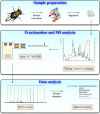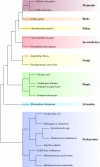Quantitative proteomics by metabolic labeling of model organisms
- PMID: 19955089
- PMCID: PMC2808257
- DOI: 10.1074/mcp.R900001-MCP200
Quantitative proteomics by metabolic labeling of model organisms
Abstract
In the biological sciences, model organisms have been used for many decades and have enabled the gathering of a large proportion of our present day knowledge of basic biological processes and their derailments in disease. Although in many of these studies using model organisms, the focus has primarily been on genetics and genomics approaches, it is important that methods become available to extend this to the relevant protein level. Mass spectrometry-based proteomics is increasingly becoming the standard to comprehensively analyze proteomes. An important transition has been made recently by moving from charting static proteomes to monitoring their dynamics by simultaneously quantifying multiple proteins obtained from differently treated samples. Especially the labeling with stable isotopes has proved an effective means to accurately determine differential expression levels of proteins. Among these, metabolic incorporation of stable isotopes in vivo in whole organisms is one of the favored strategies. In this perspective, we will focus on methodologies to stable isotope label a variety of model organisms in vivo, ranging from relatively simple organisms such as bacteria and yeast to Caenorhabditis elegans, Drosophila, and Arabidopsis up to mammals such as rats and mice. We also summarize how this has opened up ways to investigate biological processes at the protein level in health and disease, revealing conservation and variation across the evolutionary tree of life.
Figures




Similar articles
-
Metabolic labeling of C. elegans and D. melanogaster for quantitative proteomics.Nat Biotechnol. 2003 Aug;21(8):927-31. doi: 10.1038/nbt848. Epub 2003 Jul 13. Nat Biotechnol. 2003. PMID: 12858183
-
Metabolic labeling of model organisms using heavy nitrogen (15N).Methods Mol Biol. 2011;753:29-42. doi: 10.1007/978-1-61779-148-2_2. Methods Mol Biol. 2011. PMID: 21604113
-
Using 15N-Metabolic Labeling for Quantitative Proteomic Analyses.Methods Mol Biol. 2017;1546:235-243. doi: 10.1007/978-1-4939-6730-8_20. Methods Mol Biol. 2017. PMID: 27896773
-
Stable isotope-coded proteomic mass spectrometry.Curr Opin Biotechnol. 2003 Feb;14(1):101-9. doi: 10.1016/s0958-1669(02)00014-9. Curr Opin Biotechnol. 2003. PMID: 12566009 Review.
-
Advances in quantitative proteomics via stable isotope tagging and mass spectrometry.Curr Opin Biotechnol. 2003 Feb;14(1):110-8. doi: 10.1016/s0958-1669(02)00018-6. Curr Opin Biotechnol. 2003. PMID: 12566010 Review.
Cited by
-
Viruses and antiviral immunity in Drosophila.Dev Comp Immunol. 2014 Jan;42(1):67-84. doi: 10.1016/j.dci.2013.05.002. Epub 2013 May 13. Dev Comp Immunol. 2014. PMID: 23680639 Free PMC article. Review.
-
Advances in stable isotope labeling: dynamic labeling for spatial and temporal proteomic analysis.Mol Omics. 2022 Aug 15;18(7):579-590. doi: 10.1039/d2mo00077f. Mol Omics. 2022. PMID: 35723214 Free PMC article. Review.
-
In-vivo quantitative proteomics reveals a key contribution of post-transcriptional mechanisms to the circadian regulation of liver metabolism.PLoS Genet. 2014 Jan;10(1):e1004047. doi: 10.1371/journal.pgen.1004047. Epub 2014 Jan 2. PLoS Genet. 2014. PMID: 24391516 Free PMC article.
-
Identifying proteins that bind to specific RNAs - focus on simple repeat expansion diseases.Nucleic Acids Res. 2016 Nov 2;44(19):9050-9070. doi: 10.1093/nar/gkw803. Epub 2016 Sep 12. Nucleic Acids Res. 2016. PMID: 27625393 Free PMC article. Review.
-
Quantitative phosphoproteomics after auxin-stimulated lateral root induction identifies an SNX1 protein phosphorylation site required for growth.Mol Cell Proteomics. 2013 May;12(5):1158-69. doi: 10.1074/mcp.M112.021220. Epub 2013 Jan 17. Mol Cell Proteomics. 2013. PMID: 23328941 Free PMC article.
References
-
- Bridges C. B. (1914) Direct proof through non-disjunction that the sex-linked genes of Drosophila are borne by the X-chromosome. Science 40, 107–109 - PubMed
-
- Lederberg J., Tatum E. L. (1946) Gene recombination in Escherichia coli. Nature 158, 558–558 - PubMed
-
- Hedges S. B. (2002) The origin and evolution of model organisms. Nat. Rev. Genet. 3, 838–849 - PubMed
-
- Hamann A., Brust D., Osiewacz H. D. (2008) Apoptosis pathways in fungal growth, development and ageing. Trends Microbiol. 16, 276–283 - PubMed
-
- Bowers K., Stevens T. H. (2005) Protein transport from the late Golgi to the vacuole in the yeast Saccharomyces cerevisiae. Biochim. Biophys. Acta 1744, 438–454 - PubMed
Publication types
MeSH terms
Substances
LinkOut - more resources
Full Text Sources
Other Literature Sources
Molecular Biology Databases

